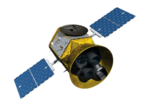Astronomy:Explorer 16
| Mission type | Space physics | ||||||||||||
|---|---|---|---|---|---|---|---|---|---|---|---|---|---|
| Operator | NASA | ||||||||||||
| Harvard designation | 1962 Beta Chi 1 | ||||||||||||
| COSPAR ID | 1962-070A[1] | ||||||||||||
| SATCAT no. | 506 | ||||||||||||
| Mission duration | 7 months | ||||||||||||
| Spacecraft properties | |||||||||||||
| Launch mass | 100.8 kg (222 lb) | ||||||||||||
| Start of mission | |||||||||||||
| Launch date | 16 December 1962, 14:38 UTC[2] | ||||||||||||
| Rocket | Scout X-3 | ||||||||||||
| Launch site | Wallops LA-3 | ||||||||||||
| End of mission | |||||||||||||
| Last contact | July 1963 | ||||||||||||
| Orbital parameters | |||||||||||||
| Reference system | Geocentric | ||||||||||||
| Regime | Low Earth | ||||||||||||
| Eccentricity | 0.02933[1] | ||||||||||||
| Perigee altitude | 750 km (470 mi)[1] | ||||||||||||
| Apogee altitude | 1,181 km (734 mi)[1] | ||||||||||||
| Inclination | 52°[1] | ||||||||||||
| Period | 104.3 minutes[1] | ||||||||||||
| Epoch | 16 December 1962[1] | ||||||||||||
| Instruments | |||||||||||||
| |||||||||||||
Explorers | |||||||||||||
Explorer 16, also called S-55B, was an United States satellite launched as part of the Explorers program. Explorer 16 was launched on December 19, 1962, at Wallops Flight Facility, Virginia, United States , with a Scout rocket.
Mission
Explorer 16 was the second in the series of micrometeoroid satellites orbited by NASA. Its purpose was to obtain data on the near-earth meteoroid environment, thus providing an accurate estimate of the probability of penetration in spacecraft structures by meteoroids and allowing a more confident definition of the relationship between penetration flux and material thickness to be derived.
The cylindrically shaped spacecraft, about 61 by 192 centimetres (24 in × 76 in), was built around the burned-out fourth stage of the Scout launch vehicle that remained as part of the orbiting satellite. Explorer 16 carried stainless steel pressurized-cell penetration detectors, impact detectors, capacitor detectors, and cadmium sulfide cell detectors to obtain data on the size, number, distribution, and momentum of dust particles in the near-earth environment. The spacecraft operated satisfactorily during its 7-month life (December 16, 1962, to July 1963), and all mission objectives were accomplished.[1]
References
- ↑ 1.0 1.1 1.2 1.3 1.4 1.5 1.6 1.7 "S 55B". NSSDC Master Catalog. NASA Goddard Space Flight Center. https://nssdc.gsfc.nasa.gov/nmc/spacecraft/display.action?id=1962-070A.
 This article incorporates text from this source, which is in the public domain.
This article incorporates text from this source, which is in the public domain.
- ↑ "Jonathan's Space Page". http://www.planet4589.org/space/log/launchlog.txt.


